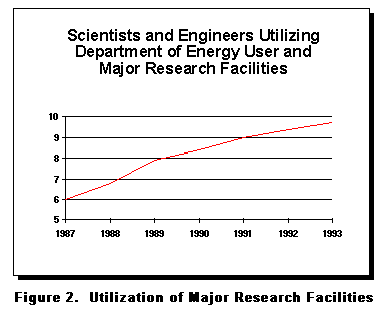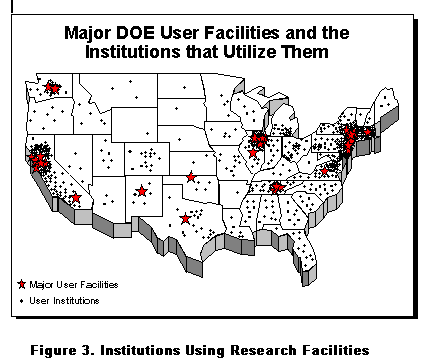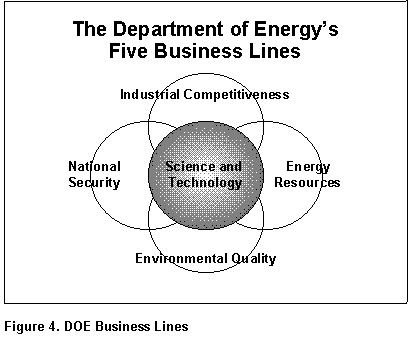




On August 3, 1994, the Clinton Administration announced a new National science policy aimed at maintaining world leadership in basic science, mathematics and engineering. Titled Science in the National Interest, the policy document ranks among the most significant Presidential statements on the importance of fundamental science in the past fifty years. The Nation's investment in research and development is heralded for having produced "a scientific enterprise without peer," and our scientific strength is characterized as "a treasure which we must sustain and build on for the future."
The treasure which comprises our scientific establishment involves public and private institutions, researchers, facilities and instrumentation located throughout the Nation. The myriad laboratories and individuals -- and the American public which has provided them with federal public support -- all have reason to celebrate the historic accomplishments which our scientific enterprise has provided, at an accelerating pace, particularly since the end of World War II. We all must also confront the challenges of the future as we seek to sustain U.S. scientific excellence and work to strengthen the role of science in serving core National needs in areas such as improved health care, environmental protection, economic competitiveness, and national security.
In developing a new National science investment strategy, Science in the National Interest states that "we must reexamine every element of the enterprise" to ensure that each element is as strong as it can be given limited resources. The fundamental science portfolio of the Department of Energy (DOE), and particularly of its laboratories, represents one of the nation's major scientific assets, and appropriately should be reexamined as the Nation addresses the challenges and opportunities of a post-Cold War world.
This paper reviews the role of science and technology at the Department of Energy's laboratories and discusses the Department's contributions of the DOE laboratory system to the Nation's research infrastructure. The National goals delineated in Science in the National Interest are used as the structure for describing the contributions of the DOE laboratory system[Note 10] in the past, and for providing recommendations aimed at achieving continued scientific excellence in the future.



The Department of Energy Laboratories have a rich science and technology base and a tradition of pursuing knowledge at the frontiers of science. As a result, many major scientific accomplishments have emerged from research conducted at the DOE Laboratories. [See "Selected Accomplishments" box] These range from conducting pioneering work on the fundamental structure of matter to expanding our understanding of the global environment to developing technologies to map the human genome.
The construction and operation of large-scale, basic research user facilities has been one of the distinguishing characteristics of the Department of Energy. The origins of this mode of research date back to the invention of the cyclotron in 1929 by Ernest O. Lawrence in Berkeley, California. In 1931, Lawrence established what then was called the Radiation Laboratory to tackle large-scale science in an intentional and intensely multi-disciplinary fashion. To help achieve this purpose, Lawrence built a large cyclotron which was of a scale and character unlike anything that could be built or sustained within an academic setting. His laboratory was the genesis of the present Lawrence Berkeley Laboratory. The cyclotron project set the stage for the development and operation of a series of major research and user facilities which have been signature contributions by the Department's laboratories to the Nation for the past 60 years. Lawrence's work also established the multi-disciplinary approach to problem solving which has been a hallmark of the research environment at the DOE Laboratories ever since.
Among the major research facilities at the Laboratories are major particle accelerators which have effectively defined the fields of high energy and nuclear physics over the past 50 years. Through the construction and operation of a series of powerful particle accelerators, the Laboratories have discovered many of nature's most fundamental particles and revealed the forces which govern their interactions. Recent evidence of the "top quark," the sixth of nature's basic building blocks, through research at DOE's Fermi National Accelerator Laboratory exemplifies such work -- which has helped create the foundation of knowledge that underpins other fields of science.
In the 1950s, the Laboratories developed the means of utilizing a by-product of accelerator operations -- synchrotron radiation -- for exploring new frontiers in materials, chemical, and life science research. The Department's synchrotron radiation facilities (commonly referred to as "light sources") generate powerful beams of ultraviolet light and x-rays for studying materials at the molecular level. These light sources have become indispensable tools for research in areas as diverse as studying materials for integrated circuits, mapping the structure of industrial chemicals, and designing molecules for future use in pharmaceuticals.
The Laboratories also have built and operated facilities which generate powerful sources of neutrons. Because neutrons are uncharged, they can penetrate deeply into sample materials and give precise information on the positions and motions of individual atoms. The neutron research facilities of the Laboratories have provided major advances in our understanding of materials such as superconducting materials, polymers, and liquid crystals used in portable computer displays. These facilities also are a source of radioisotopes for medical, research, and industrial applications. In fact, the field of nuclear medicine and the medical use of radioisotopes trace their origins to work at the DOE Laboratories.
The Department currently operates more than 60 major research and user facilities that provide access to scientific frontiers that would not otherwise be reached for materials, medical, chemical, biological, and pharmacological research. More than 9700 scientists and engineers utilized these major facilities in 1993, representing more than a 50 percent increase over the past six years (Figure 2). Researchers using these facilities represented 278 U.S. colleges and universities, 265 U.S. companies, and 47 U.S. laboratories (Figure 3). The thousands of researchers who conduct their work at these facilities often do so in collaborative teams that combine the complementary strengths and perspectives from industry, academia and the federal government . The resultant contributions of these research performers are measured in the scores of scientific papers, proceedings, patents, and commercial products that emanate from their supporting institutions.


The major research and user facilities of the Department's Laboratories exist in synergy with an in-house research staff that complements, but is not necessarily dependent upon, such facilities. For example, small teams of principle investigators at the Laboratories have provided major contributions in areas such as atmospheric chemistry, microbiology, catalysis, and even cosmology. If there is one ubiquitous tool within the Laboratory system, however, it is high performance computers. From the earliest days of computers to the present, the Laboratories have been among the world's leading experts in computational science, modeling, and simulation. Initially driven by the data management requirements of national security, fusion energy, and high energy physics applications, these systems now are fully engaged by the Laboratories in National challenges including global climate modeling, designing fuel-efficient automobiles, and human genome research.



The examples listed above provide but a few illustrations of scientific and technological accomplishments of the Department and its Laboratories. However, these examples, in-and-of-themselves, do little to convey the cardinal importance of science and technology to the overall success of the Department in meeting its assigned missions. It is no understatement to say that science and technology are the most important means through which a majority of the Department's activities are conducted. This reality is made clear in the Department's May 1994 strategic plan, Fueling a Competitive Economy, which positions science and technology at the center of the Department's five major business lines -- intersecting and amplifying each mission (Figure 4).




The Department's total science and technology investment for Fiscal Year 1994 was $7.3 billion,[Note 11] amounting to approximately 40 percent of the Department's overall Fiscal Year 1994 budget of $19 billion, and 10 percent of the total federal R&D budget of $74 billion.[Note 12] The Department's $3.4 billion funding of basic and applied research (excluding technology development, equipment, and construction) is fourth among the 16 agencies that are the primary Federal supporters of science and technology. This level follows the National Institutes of Health at $8.9 billion, the Department of Defense at $4.3 billion, and the National Aeronautics and Space Administration at $4.1 billion. The Department of Energy supports the largest federal program in materials research and funds 90 percent of the nation's research in high energy physics.
The Department executes its science and technology function in many ways, including through grants to university researchers, cost-shared research programs with industry, construction and operation of major scientific user facilities, and laboratory-based research programs. For example, the Department's research program supports approximately 1800 university R&D grants totaling more than $600 million annually at more than 100 U.S. universities.
The organization and management of the Department's research programs is the primary responsibility of the Department's program managers, who develop and manage research programs in response to legislative and Executive Branch direction. These programs are executed through research performed across a range of R&D performers, sometimes including multiple universities, companies, and DOE laboratories. Through peer evaluation and program reviews, the Departmental program managers ensure that the individual tasks among distributed researchers are integrated and are contributing toward the overall research objectives of the program.



The basic and applied research programs of the Department and its laboratories fit well and fully within the goals that are stated in the August 1994 National science policy document, Science in the National Interest. This section describes current activities and past accomplishments for each of the goals delineated in the White House science policy.[Note 13] Recommendations are also included that have been developed by the Department as a means of helping achieve these National goals.
Goal: Maintain Leadership Across the Frontiers of Scientific Knowledge
Through its laboratory programs, including through its major research and user facilities, the Department is engaged in scientific exploration that spans from the fundamental building blocks of matter to the far reaches of the Universe to practical applications of physical and biological science.
Research conducted at Department of Energy laboratories has excelled within its disciplines, and also has helped create entirely new fields of scientific inquiry. For example, the Human Genome Program was conceived and initiated by the Department of Energy -- growing out of its long-standing research aimed at measuring radiation-induced mutations in cells and combining that research base with the National Laboratories' exceptional computational abilities. Similarly, the Laboratories have played a major role in establishing and shaping the research agenda in high energy and nuclear physics, plasma physics, nuclear medicine, nuclear engineering, supercomputing, and global climate modeling.
Scientific excellence and leadership has earned an impressive array of scientific awards to the Department. More than 58 Nobel prize winners since 1936 have been supported by the Department of Energy at some time in their careers. Eighteen Nobel prizes have been awarded to Department of Energy laboratory employees, and another 13 to researchers who employed National Laboratory facilities in their award-winning discoveries. Most of the 40 winners of the prestigious Enrico Fermi Presidential awards have done research supported by the Department. Many additional award and distinctions have been presented to Laboratory employees for their contributions in science and technology, including from the National Academy of Sciences, Smithsonian, American Physical Society, and many other scientific organizations.
New facilities under construction by the Department promise continued scientific discovery and world leadership. For example, new ultra-violet and X-ray radiation sources at the Lawrence Berkeley Laboratory and at the Argonne National Laboratory will enable studies of the structure of metals, alloys, ceramics, polymers, and biological molecules, such as proteins and viruses. These studies hold the potential for revolutionary advances in understanding of materials and could result in major future commercial applications in products ranging from fabrics and plastics to designer drugs and computer chips.
Although the Department's laboratories have a long record of scientific excellence, the challenge is to achieve continuous improvement during a period of scarce resources. The following strategies will help the Department contribute to the National goal of maintaining leadership across the frontiers of scientific knowledge:
Goal: Enhance Connections Between Fundamental Research and National Goals
The Department of Energy has major National mission responsibilities in the areas of energy resources, national security, fundamental science, and environmental quality. The Department has invested heavily in science and technology to uphold these responsibilities. Science at the National Laboratories in support of these areas is wide-ranging, encompassing both long- and short-term basic and applied research. However, in order to meet the Department's challenging goals for the future, the connections between fundamental research and mission objectives will need to be tighter than ever before.
The following strategies will help the Department contribute to the National goal of enhancing the connections between fundamental research and national needs.
Goal: Stimulate partnerships that promote fundamental science and engineering and effective use of physical, human, and financial resources
Partnership mechanisms for working with the DOE Laboratories include consulting agreements for university professors, long-term guest assignments for industrial and foreign researchers, user programs for major facilities, cost-shared contracts, and Cooperative Research and Development Agreements (CRADAs). The first two mechanisms are particularly effective in promoting broad-based fundamental research.
Partnerships with university and industrial scientists and engineers are a central operating approach at the DOE Laboratories. This is evidenced, for example, by the more than 20,000 scientists and engineers who were guests at the multi-program laboratories in 1993; approximately one-third were from industry.[Note 14] At the Oak Ridge National Laboratory alone last year, guest scientists and engineers numbered almost 4400, more than double the number five years earlier. Of these, 1700 were industry participants, an increase of 22 percent over the number in 1991. These guests represented the equivalent of about 1500 additional full-time laboratory scientists, effectively doubling the productive scientific workforce at Oak Ridge. Experience at the other National Laboratories is similar. These partnerships are helping the productivity and vigor of the laboratories while benefiting industry and contributing to the Nation's science and technology enterprise.
Assignments of faculty, students, and industrial scientists to laboratories generally are paid for by the supporting organizations.[Note 15] In addition, companies invest significant funds at the laboratories in support of experimental use at user facilities, such as the Department's advanced light sources. At the National Synchrotron Light Source at the Brookhaven National Laboratory, many industrial users have spent $2 - $3 million apiece to provide the beam line equipment for their experiments. Since this equipment is of use only to the facility, it is left behind for other users when the industrial partner has completed its work. Costs for beam lines at the new Advanced Light Source and the Advanced Photon Source are substantially greater because of the greater complexity and capability of the facilities. Access to the beam lines at these new facilities has already been claimed by dozens of teams of government, academic, and industrial users. [See "User Facilities" box] The total investment so far by industry in equipment at DOE light sources is in excess of $100 million.
The Department currently has more than 1000 CRADAs with over 700 industrial partners. While the majority of these partnerships are related to specific product or development efforts, almost 20 percent involve basic research. An even larger fraction involve work that has grown out of previously sponsored basic research. The Department and the Laboratories continue to seek CRADA arrangements with companies interested in advancing basic science.
Improved partnership arrangements could further promote the effectiveness of the Laboratories, and increasingly are essential in meeting National needs. The following strategies will help the Department contribute to the National goal of stimulating additional, effective partnerships that promote science and engineering:
Goal: Produce the Finest Scientists and Engineers for the Twenty-first Century and Raise the Scientific and Technological literacy of all Americans
DOE has capabilities that distinguish it from other agencies and institutions and allow it to make significant contributions to this National goal. The laboratories large scientific work force, geographic diversity, world-class scientific facilities, technology development expertise, and capabilities in forming partnerships allow the Department to provide technical training and public enrichment experiences throughout the country. These facilities are major sites for undergraduate and graduate research performed as part of the normal educational curricula for thousands of students.
College and university-based education programs have been supported since the early days of the Atomic Energy Commission through student fellowships and research opportunities, curriculum development, and faculty enhancement. Undergraduate programs are conducted at both two-year and four-year institutions. Graduate and post-doctoral programs enhance research opportunities through fellowships at home institutions and Department of Energy facilities. Representative undergraduate and graduate programs include:
The Department also makes significant contributions to all levels of mathematics and science education to help enhance the literacy of the public in science, mathematics and engineering. The Department's funding for pre-college education programs (K-12) has increased by approximately 400 percent over the past five years, reflecting the growing understanding that these early learning years are extremely important in motivating and retaining students' interest in mathematics and science.
The Department's pre-college programs improve the skills and knowledge of new and existing teachers, provide alternative learning environments, encourage curriculum reform, disseminate new materials and media, provide equipment and technical assistance to teachers, foster research on new methods and materials, and provide opportunities for students and teachers to perform research on current science and technology. Specific examples of DOE programs developed with or by the National Laboratories are:
The following strategies will help the Department contribute to the National goal of producing the finest scientists and engineers for the twenty-first century and raising the scientific and technical literacy of all Americans:
 Table of
Contents
Table of
Contents
 Next Section
Next Section